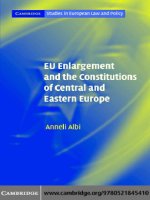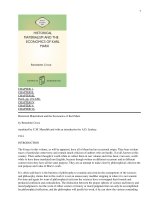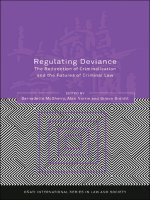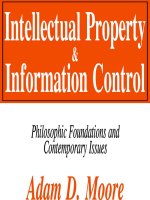Intellectual Property and the Limits of Antitrust potx
Bạn đang xem bản rút gọn của tài liệu. Xem và tải ngay bản đầy đủ của tài liệu tại đây (1.98 MB, 165 trang )
Intellectual Property and the Limits of Antitrust
NEW HORIZONS IN COMPETITION LAW AND ECONOMICS
Series Editors: Steven D. Anderman, Department of Law, University of Essex, UK and
Rudolph J.R. Peritz, New York Law School, USA
This series has been created to provide research based analysis and discussion of the
appropriate role for economic thinking in the formulation of competition law and
policy
. The books in the series will move beyond studies of the traditional role of
economics – that of helping to define markets and assess market power – to explore the
extent to which economic thinking can play a role in the formulation of legal norms,
such as abuse of a dominant position, restriction of competition and substantial imped-
iments to or lessening of competition. This in many ways is the new horizon of compe-
tition law policy
.
US antitrust policy, influenced in its formative years by the Chicago School, has
already experienced an expansion of the role of economic thinking in its competition
rules. Now the EU is committed to a greater role for economic thinking in its Block
Exemption Regulations and Modernisation package as well as possibly in its reform of
Article 82.
Yet these developments still raise the issue of the extent to which econom-
ics should be adopted in defining the public interest in competition policy and what role
economists should play in legal argument. The series will provide a forum for research
perspectives that are critical of an unduly-expanded role for economics as well as those
that support its greater use.
T
itles in the series include:
Antitrust, Patents and Copyright
EU and US Perspectives
Edited by François Lévêque and Howard Shelanski
Innovation Markets and Competition
Analysis
EU Competition Law and US Antitrust Law
Marcus Glader
Competition Law and Patents
A Follow-on Innovation Perspective in the Biopharmaceutical Industry
Irina Haracoglou
Antitrust and Regulation in the EU and US
Legal and Economic Perspectives
Edited by François Lévêque and Howard Shelanski
Competition Law, Innovation and Antitrust
An
Analysis of T
ying and Technological Integration
Hedvig Schmidt
Intellectual Property and the Limits of Antitrust
A Comparative Study of US and EU Approaches
Katarzyna Czapracka
Intellectual Property
and the Limits of
Antitrust
A Comparative Study of US and EU
Approaches
Katarzyna Czapracka
Associate, White & Case LLP, Belgium
NEW HORIZONS IN COMPETITION LAW AND ECONOMICS
Edward Elgar
Cheltenham, UK • Northampton, MA, USA
© Katarzyna Czapracka 2009
All rights reserved. No part of this publication may be reproduced, stored in a
retrieval system or transmitted in any form or by any means, electronic, mechanical or
photocopying, recording, or otherwise without the prior permission of the publisher.
Published by
Edward Elgar Publishing Limited
The Lypiatts
15 Lansdown Road
Cheltenham
Glos GL50 2JA
UK
Edward Elgar Publishing, Inc.
William Pratt House
9 Dewey Court
Northampton
Massachusetts 01060
USA
A catalogue record for this book is available from the British Library
Library of Congress Control Number: 2009936744
ISBN 978 1 84720 925 2
Typeset by Cambrian Typesetters, Camberley, Surrey
Printed and bound by MPG Books Group, UK
02
Contents
Acknowledgements vi
Introduction vii
Table of statutes xiii
Table of cases xv
1 The roots of the transatlantic clashes 1
2 Striking the balance between antitrust and IP 36
3 (Mis)use of regulatory procedures and IP 92
4 Trade secrets and antitrust: an example of the conflicting
US and EU approaches 112
Index 135
v
Acknowledgements
My deepest gratitude goes to my teachers and advisors. The Chair of my JSD
Committee, Professor Petros C. Mavroidis, has been a great source of inspira-
tion since the beginning of my studies at Columbia Law School. The ideas and
comments of Professor Harvey J. Goldschmid challenged my thinking and
broadened my horizons. I would also like to thank the editors of the New
Horizons in Law and Economics series for their comments and suggestions,
which have been really helpful. All remaining mistakes are mine.
The cut-off date for the book has been a moving target, but I have attempted
to cover the developments through the end of 2008.
The text draws on the JSD thesis I defended at Columbia School of Law in
2007. The opinions expressed are strictly personal.
vi
Introduction
Application of antitrust rules to intellectual property (IP) has always been a
perplexing subject. It has recently gained importance in the context of new
technologies and the associated market developments. Over the past few
years, the US and EU antitrust enforcers have taken steps to reevaluate their
approach to IP rights and to tackle the related issues concerning application of
the antitrust rules in high-tech sectors of the economy. In the US the Federal
Trade Commission (FTC) and the Department of Justice (DOJ) held months-
long hearings focusing on the intersection of antitrust and IP laws in 2002 and
published two reports on the topic. Both IP and high-technology industries
were among the issues addressed in the 2007 report published by the Antitrust
Modernization Commission. The agencies have also brought a number of
high-profile cases involving information technology (IT) industries and IP
rights, including Microsoft,
1
Intel
2
and Rambus.
3
Moreover, the Supreme
Court addressed issues of vital importance to the antitrust and intellectual
property intersection in the Illinois Tool
4
and Trinko
5
cases.
Equally fundamental developments have taken place on the other side of
the Atlantic. In the spring of 2004, the European Commission adopted a new
Technology Transfer Block Exemption Regulation
6
and ruled that Microsoft’s
refusal to provide interoperability information to its rivals constituted an abuse
of a dominant position. In 2005, the Commission adopted a ground-breaking
decision in the AstraZeneca case
7
– the first case in which EU competition law
has been applied to an alleged misuse of the patent system and the procedures
for marketing pharmaceuticals. In the same year, the Commission published
vii
1
U.S. v. Microsoft Corp., 253 F.3d 34 (D.C. Cir. 2001).
2
In the Matter of Intel Corporation, Docket No. 9288, available at:
/>3
In the Matter of Rambus Incorporated, Docket No. 9302, available at:
/>4
Illinois Tool Works Inc. v. Independent Ink, Inc., 126 St. Ct. 1281 (2006).
5
Verizon Communications Inc. v. Law Offices of Curtis v. Trinko, LLP, 540 U.S.
398 (2004). Although the case does not involve IP rights, it is of vital importance for
cases involving a refusal to license IP rights.
6
Commission Regulation No. 772/2004 of 27 April 2004 on the application of
Article 81(3) of the Treaty to categories of technology transfer agreements, OJ (L 123)
11 (2004).
7
Commission Decision in COMP/37.507 – Generics/AstraZeneca (2005).
the Article 82 Discussion Paper, which outlined the Commission’s views on
the assessment of unilateral conduct involving intellectual property rights
under competition laws.
8
In 2007, the Court of First Instance (CFI) delivered
the long- awaited judgment in the Microsoft case, upholding the Commission’s
position on Microsoft’s obligations to share interoperability information with
its competitors,
9
and the Commission also issued a statement of objections in
a first case involving an alleged patent ambush. The pharmaceutical sector
inquiry launched by the Commission in 2008 targeted patent settlements
between generic and brand name pharmaceutical companies.
10
Many of these
recent cases involved a direct conflict between IP rights and antitrust laws,
where the ordered remedies deprived the right holders of exclusivity either by
imposing licensing obligations or by limiting their ability to enforce their
rights.
The recent developments highlight a growing divergence between the EU
and US antitrust enforcers over the approach to the application of antitrust
rules to IP rights. This is so even though there is a broad analytical consensus
as to the economic principles governing the application of antitrust rules to IP
rights. It is equally accepted on both sides of the Atlantic that IP rights do not
create monopolies, that IP and antitrust rules have the common objective of
stimulating innovation and economic growth, and that IP rights need to be
treated with some level of deference so that antitrust enforcement does not
undermine the objectives of IP policy. It also appears that in both jurisdictions
the antitrust authorities focus on dynamic competition and incentives to inno-
vate.
viii Intellectual property and the limits of antitrust
8
See European Commission, Directorate General for Competition, DG
Competition Discussion Paper on the Application of Article 82 of the Treaty to
Exclusionary Abuses, 19 Dec. 2005, />others/discpaper2005.pdf (Article 82 Discussion Paper). In December 2008, following
the public consultations the Commission adopted Guidance on the Commission’s
Enforcement Priorities in Applying Article 82 EC T
reaty to Abusive Exclusionary
Conduct by Dominant Undertaking, Communication from the Commission, COM
(2008). The new document, much shorter than the Discussion Paper, does not elaborate
on the Commission’
s approach to IP and interoperability information.
9
Case T-201/04, Microsoft Corp. v. Commission (Microsoft judgment), 2007
E.C.R. II-3601.
10
See DG Competition Staff Working Paper, Pharmaceutical Sector Inquiry
Preliminary Report, 28 Nov. 2008, at />ceuticals/inquiry/exec_summary_en.pdf. The Report does not identify wrongdoing of
individual companies or provide guidance on the compatibility of certain behavior with
EU competition law, but concludes that brand name companies engaged in practices
that delayed market entry of generic medicines and possibility limited innovation in the
pharmaceutical sector.
The Commission announced public consultations to consider
steps to address these issues.
This book strives to offer a better understanding of the roots of the differ-
ences in the application of antitrust principles to IP rights. It focuses on unilat-
eral conduct and on cases where antitrust remedies deprive the right owner of
exclusivity, the core of an IP right. This area merits special attention for two
reasons. First, it is the source of the greatest differences in the approaches of
EU and US antitrust enforcers to IP rights. Second, it is the area where the
application of antitrust rules to IP rights can have the direst consequences for
the right holders.
Whereas the scope of antitrust laws has been shrinking in the United States,
EU competition law has been consistently used to regulate a number of issues
that are considered to be outside the scope of the Sherman Act. In the United
States, unilateral conduct involving exercise of a valid IP right can hardly give
rise to liability under antitrust rules and antitrust authorities have been reluc-
tant to intervene in what is perceived to be the sphere of IP policy. In contrast,
the EU antitrust enforcers have been much more active than their US counter-
parts in addressing the consequences of what they perceive as imperfect IP
laws, thus reshaping the substantive standards for IP protection. In a few cases
involving difficult questions relating to the scope of IP rights, the Commission
and the EU courts have ruled that, in limited circumstances, a dominant
company may violate Article 82 by refusing to license a valid IP right to its
competitors. Allocation of the burden of proof is also significant. For example,
in the recent Microsoft ruling, the CFI required that the dominant company
submit evidence showing that compulsory licensing would have ‘a significant
negative impact on its incentives to innovate’ in order to justify its refusal to
share its IP with competitors.
11
At the same time, it appears that the Court was
satisfied that a compulsory license would stimulate follow-on innovation on
the basis of less concrete evidence than was required in previous compulsory
licensing cases.
One reason for these divergences is that EU and US courts assess market
power and its abuse quite differently. Monopolization under §2 of the Sherman
Act and an abuse of a dominant position under Article 82 of the EC Treaty
comprise two elements: possession of market power and anticompetitive
conduct. Yet, there are major differences between the EU and US rules relating,
for example, to the definition of dominance, the assessment of what constitutes
anticompetitive conduct, and the requirement of a causal link between mainte-
nance of monopoly power and anticompetitive conduct. Whereas §2 of the
Sherman Act is designed to protect competition by prohibiting the acquisition
or maintenance of ‘monopoly power’, Article 82 is used to regulate the actions
of companies in ‘dominant positions’. One of the principles repeated in EU
Introduction ix
11
Microsoft judgment, ¶697.
case law is that dominant companies have a ‘special responsibility’ not to
impair competition in the market. The EU antitrust enforcers have been recep-
tive to the idea that monopolists may be required to provide certain services or
share the essential inputs which they control. They advocate a relatively wide
scope for antitrust intervention in cases involving unilateral refusals to deal,
including refusals to license IP rights and to provide interoperability informa-
tion. By contrast, the US Supreme Court questioned the merit of ‘enforced
sharing’ in the Trinko case and set a very narrow scope for antitrust scrutiny of
unilateral refusals to deal.
12
In the United States, there is a more general reluc-
tance towards regulating the future conduct of companies with market power
as it is perceived to potentially have a chilling effect on beneficial, pro-
competitive activities.
The transatlantic differences relating to the assessment of market domi-
nance are only a partial explanation for the clashes over IP rights. An equally
important issue is the application of antitrust laws to market distortions result-
ing from a government action. In unregulated markets, competition enforce-
ment may remedy specific market failures. In regulated markets, competition
law may also be used to address externalities created by regulatory activity.
Patents, copyrights, trademarks, trade secrets and other forms of IP give their
owners some exclusivity over the particular use and expression of a piece of
information. The relation between antitrust law and regulation that may
disrupt competitive processes is vital for the antitrust analysis of anticompeti-
tive concerns resulting from IP rights. The differences in the approaches taken
by the EU and US antitrust enforcers to these issues are even greater than those
relating to the scrutiny of companies exercising their market power. The
Sherman Act is generally inapplicable to actions by a state operating in its
sovereign capacity or to private conduct approved and supervised by a state as
a matter of state policy. In contrast, EU competition law has been used to curb
anticompetitive policies at the national level and to erode the position of
national monopolies. The roles of competition law and industrial policy have
never been clearly delineated and the European Commission has been using
competition law to promote industrial policy goals. Laws of the Member
States may be and have been challenged as anticompetitive. This is also the
case with IP laws, which are still largely regulated at the national level. Some
commentators have interpreted the EU compulsory licensing decisions as a
means to deal with what was considered an ‘aberrant’ national IP right.
Just as with state action, the use of government process by private parties
may give rise to competitive concerns. Again, there are significant differences
as to how antitrust enforcers approach such conduct in the two jurisdictions.
x Intellectual property and the limits of antitrust
12
Trinko, 540 U.S. at 408.
In the United States the Noerr-Pennington doctrine provides antitrust immu-
nity to those who use genuine efforts to influence public officials. Persons who
seek action from any branch of the state or federal government by using
administrative procedures or bringing a court action are immune from antitrust
scrutiny, unless their action is a mere ‘sham’ to cover an attempt to interfere
directly with a competitor’s business relationships. While the status of
antitrust immunity for government petitioning is uncertain in the EU, the
available case law suggests that EU antitrust enforcers are more likely to chal-
lenge such conduct than their US counterparts. This has important conse-
quences for the antitrust scrutiny of acquisition and enforcement of IP rights.
As mentioned above, the most common §2 challenges in the United States
against IP owners involve allegations that their rights are invalid or improperly
enforced. But the scope of antitrust scrutiny in such cases is rather limited,
because these claims are very narrowly crafted and require a high burden of
proof. To prevail on a Walker Process claim, for example, the antitrust plain-
tiff must show an intentional fraud on the Patent Office, causation, and other
elements of a §2 violation. Similarly, an action to enforce an invalid IP right
can be challenged under §2 only if it is objectively baseless, which requires
showing that no reasonable litigant could realistically expect success on the
merits.
In AstraZeneca, the European Commission suggests a lower standard of
antitrust liability in cases involving acquisition or enforcement of IP rights In
this case, the Commission alleged that AstraZeneca abused its dominant posi-
tion by giving misleading information to several national patent offices in
order to extend patent protection for one of its drugs. The Commission
advanced the view that it is sufficient that the dominant company knowingly
provides ‘misleading’ information; it did not allege that AstraZeneca’s conduct
was a ‘sham’ or amounted to fraud. Notably, the patent cases initiated by
AstraZeneca’s conduct were referred to the ECJ for clarification of the applic-
able EU regulations. The lack of clarity in applicable laws was no excuse. The
Commission’s position seems to be that a dominant company must refrain
from exploiting uncertainties in applicable laws to preserve its exclusive
rights. Moreover, the element of causation is not required to establish an abuse
of Article 82, meaning that an act of petitioning may be abusive regardless of
whether it would result in issuing an invalid patent. All in all, the AstraZeneca
case suggests that acquisition and enforcement of IP rights will be subjected
to greater antitrust scrutiny in the EU as compared with the US regime.
Application of antitrust rules to address imperfections in IP laws may offer
significant advantages, especially given that IP policy makers often do not
take due account of competition values. Still, it also has dangerous implica-
tions. Antitrust authorities are not always best positioned to create substantive
standards for IP protection. Unduly restrictive antitrust rules may undermine
Introduction xi
the coherence of the IP system. In the pursuit of equilibrium between IP and
antitrust law, European enforcers have embraced theories that may have led to
a desirable outcome in a particular case but are unsuitable or too vague to
serve as a general rule.
An example of such overeager antitrust enforcement is the application of
antitrust laws to trade secrets. Both in the US and in the EU, ‘federal’ antitrust
rules trump inconsistent trade secret laws adopted at the state level. Yet while
the US antitrust authorities treat trade secrets with the same level of deference
as IP rights, the European Commission does not. In the course of enforcing
competition rules, the Commission adopted a definition of protectable trade
secrets, asserted that they are not a form of property, and concluded that they
do not merit the same level of protection as IP rights. In doing so, the
Commission has been predominantly concerned with the need to ensure free
competition and less with the companies’ need to protect their valuable know-
how. It has also ignored the basic principles of trade secret laws, thus under-
mining national trade secret protection measures.
It is crucial that the antitrust enforcers take due account of the applicable IP
laws and clearly state the limiting principles, so that there is no doubt which
conduct may be considered an antitrust violation. In this context, the recent
decision of the Court of First Instance in the Microsoft case is particularly
disappointing. The decision failed to clarify some of the important questions
of law raised by the Microsoft case and further blurs the picture when it comes
to the assessment of unilateral refusals to license under Article 82.
This book is organized as follows. The first chapter addresses the differ-
ences between the core EU and US antitrust principles crucial for the applica-
tion of antitrust laws to IP rights, including the major differences between the
monopolization offense and the abuse of dominance, the state action doctrine
and the immunity for government petitioning, all of which are crucial to the
understanding of the limits of antitrust intervention in the EU and in the US.
The following chapters discuss examples of conduct involving IP rights that
may amount to an antitrust violation in the two jurisdictions. The focus is on
cases where antitrust enforcement affects the core of an IP right: refusals to
license and anticompetitive acquisition or enforcement of IP rights. The last
chapter describes cases where the antitrust laws were applied to trade secrets,
showing how overeager antitrust intervention in the EU undermined national
measures designed to protect trade secrets. Trade secrets merit a separate chap-
ter also for another reason: the available case law suggests that the EU antitrust
enforcers, unlike their US counterparts, apply different rules to trade secrets
from those applied to other forms of IP.
xii Intellectual property and the limits of antitrust
Agreement on Trade-Related
Aspects of Intellectual Property
Rights, Marrakesh Agreement
Establishing the World Trade
Organization, Annex 1C, Legal
Instruments – Results of the
Uruguay Round, Part II, Section
5, 15 Apr. 1994, 1869 U.N.T.S.
299; 33 I.L.M. 1197 (1994)
113–14, 117
Berne Convention for the Protection
of Literary and Artistic Works
(Paris Act) 24 July 1971, S.
Treaty Doc. No. 99-27, 1161
U.N.T.S. 3 (1986) 44
Commission Notice – Guidelines on
the application of Article 81 of
the EC Treaty to technology
transfer agreements, 2004 OJ (C
101) 2 8, 70, 78–80, 130–31
Commission Regulation 2790/1999
on the application of Article 81(3)
of the Treaty to categories of
vertical agreements and concerted
practices, 1999 OJ (L 336) 21
80
Commission Regulation 2659/2000
of 29 November, 2000 on the
application of Article 81(3) of the
Treaty to categories of research
and development agreements, OJ
(L 304) 7 131
Commission Regulation
2349/84/EEC of 23 July 1984 on
the application of Article 85(3) of
the Treaty to certain categories of
patent licensing agreements, 1984
OJ (L 219) 15, corrected by 1985
OJ (L 13) 34 77, 126–27
Commission Regulation 556/89/EEC
of 30 November 1988 on the
application of Article 85(3) of the
Treaty to certain categories of
know-how licensing agreements,
1989 OJ (L 61) 1 126–30
Commission Regulation 240/96 of
31 January 1996 on the applica-
tion of Article 85(3) of the Treaty
to certain categories of technol-
ogy transfer agreements, 1996 OJ
(L 31) 2 126, 128–29
Commission Regulation 772/2004
on the application of Article 81(3)
of the Treaty to categories of
technology transfer agreements,
2004 OJ (L 123) 11 78–81,
130–31, 133
Communication from the
Commission, Guidance on the
Commission’s Enforcement
Priorities in Applying Article 82
EC Treaty to Abusive
Exclusionary Conduct by
Dominant Undertakings, COM
(2008) 2, 6–7, 12–13, 18–19,
57, 88
Council Directive 2001/83/EC on
the Community code relating to
medicinal products for human
use, OJ 2001 (L 311) 67 105
xiii
Table of statutes
Council Directive 2004/27/EC
amending Directive 2001/83/EC
on the Community code relating
to medicinal products for human
use, OJ 2004 (L 136) 34 105
Council Directive 65/65/EEC of 26
January 1965 on the approxima-
tion of provisions laid down by
law, regulation or administrative
action relating to proprietary
medicinal products, 1965 OJ (L
22) 369, English special edition:
Series I Chapter 1965-1966, p. 24
103
Council Directive 96/9/EC on the
legal protection of databases,
1996 OJ (L 77) 20 51
Council Directive 98/71/EC on the
legal protection of designs, OJ
1998 (L 289) 28 45
Council Regulation 1768/92/EEC
concerning the creation of a
supplementary protection certifi-
cate for medicinal products, 1992
OJ (L 182) 1 102
Council Regulation 1/2003 on the
implementation of the rules on
competition laid down in Articles
81 and 82 of the Treaty, 2003 OJ
(L 1) 1 77
Department of Justice and Federal
Trade Commission, Antitrust
Guidelines for the Licensing of
Intellectual Property (6 April
1995) 120
North American Free Trade
Agreement, 8 Dec. 1993, 107
Stat. 2057 113
Paris Convention for the Protection
of Intellectual Property, 20 Mar.
1883, 21 U.S.T. 1583, 828
U.N.T.S. 305 113
Restatement (First) of Torts
(1939) 114
Restatement (Third) of Unfair
Competition (1995) 113–115
Uniform Trade Secrets Act (1990)
114
xiv Intellectual property and the limits of antitrust
3 P.M., Inc. v. Basic Four Corp., 591
F. Supp. 1350 (D. Mich. 1984)
121
Abbott Laboratories v. Portland
Retail Druggists Assn., Inc., 425
U.S. 1 (1976) 22
AKZO Chemie BV v. Commission,
Case C-62/86, 1991 E.C.R. I-
3359 6
Alaska Airlines v. United Airlines,
948 F.2d 536 (9th Cir. 1991)
89
Albany International BV v. Stichting
Bedrijfspensioenfonds Textiel
Industrie, Case C-67/96, 1999
E.C.R. I-5751 31
Allied Tube & Conduit Corp. v.
Indian Head, 486 U.S. 492
(1988) 29–30
American Equipment Co. v. Tuthill
Bldg. Material Co., 69 F.2d 406
(7th Cir. 1934) 73
American Hoist & Derrick Co. v.
Sowa & Sons, Inc., 725 F.2d 1350
(Fed. Cir. 1984) 108
American Precision Vibrator Co. v.
National Air Vibrator Co., 764
S.W.2d 274 (Tex. App. 1988)
114
Aronson v. Quick Point Pencil Co.,
440 U.S. 257 (1979) 119
Aspen Skiing Co. v. Aspen Highlands
Skiing Corp., 472 U.S. 585
(1985) 14–16, 64–68
Atari Games Corp. v. Nintendo of
America, Inc., 897 F.2d 1572
(Fed. Cir. 1990) 37, 82, 94
Atlantic Container Line AB et al. v.
Commission, Joined Cases T-
191/98, T-212/98 to T-214/98,
2003 E.C.R. II-3275 11
Avtec Sys. v. Peiffer, 21 F.3d 568
(4th Cir. 1994) 114
Basic Am., Inc. v. Shatila, 992 P.2d
175 (Idaho 1999) 115
Bayer/Tanabe, European
Commission, Eighth Report on
Competition Policy (1978) 101
Beal Corp. Liquidating Trust v.
Valleylab, Inc., 927 F. Supp. 1350
(D. Colo. 1996) 99
Bell South Adver. & Publ’g Corp. v.
Donnelly Info Publ’g Inc, 719 F.
Supp. 1551 (S.D. Fla. 1988) 65
Bement v. National Harrow, 186
U.S. 70 (1902) 70, 93
Berkey Photo, Inc. v. Eastman
Kodak Co
., 603 F.2d 263 (2d Cir.
1979) 83, 123–29
BNIC v. Aubert, Case 136/86, 1987
E.C.R. 4789 24
Bourns, Inc. v. Raychem Corp., 331
F.3d 704 (9th Cir. 2003) 99–100
BPB Industries and British Gypsum
v. Commission, Case T-65/89,
1993 E.C.R. II-389 11
British Leyland v. Commission, Case
226/84, 1986 E.C.R. 3263 92
Broadcom Corp. v. Qualcomm Inc.,
501 F.3d 297 (3d Cir. 2007)
84–87
xv
Table of cases
Brooke Group Ltd. v. Brown &
Williamson Tobacco Corp., 509
U.S. 209 (1991) 10
Brulotte v. Thys Co., 379 U.S. 29
(1964) 120
Bundesanstalt für den
Güterfernverkehr v. Gebrüder
Reiff GmbH & Co. KG., Case C-
185/91, 1993 E.C.R. I-5801 24
Burten v. Milton Bradley Co., 763
F.2d 461 (1st Cir. 1985) 11
4
Business Electronics v. Sharp
Electronics, 485 U.S. 717 (1988)
76
C.R. Bard, Inc. v. M3 Sys., Inc., 157
F.3d 1340 (Fed. Cir. 1998) 87,
99
California Computer Products, Inc.
v. International Business
Machines Corp., 613 F.2d 727
(9th Cir. 1979) 122
California Motor Transport Co. v.
Trucking Unlimited, 404 U.S. 508
(1972) 29
California Retail Liquor Dealers
Ass’n v. Midcal Aluminum, 445
U.S. 97 (1980) 21
California Transp. Co. v. Trucking
Unlimited, 404 U.S. 508 (1972)
28
California v. Federal Power
Commission, 369 U.S. 482 (1962)
22
Cardtoons, L.C. v. Major League
Baseball Players Assoc., 208 F.3d
885 (10th Cir. 2000) 28
Carl Schenck, A.G. v. Nortron Corp.,
713 F.2d 782 (C.A. Fed. 1983)
37
Carpenter v. United States, 484 U.S.
19 (1987) 117
Centrafarm BV et Adriaan de
Peijper v. Sterling Drug Inc.,
Case 15/74, 1974 E.C.R. 1147
98
Centre belge d’études de mar
ché –
Télémarketing (CBEM) v. SA
Compagnie luxembourgeoise de
télédiffusion (CL
T) and
Information publicité Benelux
(IPB), Case 311/84, 1985 E.C.R.
3261 12
Cheminor Drugs, Ltd. v. Ethyl Corp.,
168 F.3d 119 (3d Cir
. 1999)
28
Christianson v. Colt Industries
Operating Corp., 766 F. Supp.
670 (D. Ill. 1991) 121–22
Christianson v. Colt Industries
Operating Corp., 870 F.2d 1292
(7th Cir., 1989) 121–22
CIF Consorzio Industrie Fiammiferi
v. Autorità Garante della
Concorrenza e del Mercato, Case
C-198/01, 2003 E.C.R. I-8055
24–25
Cisco Sys., Inc. v. Huawei Techs.,
Co., 266 F. Supp. 2d 551 (E.D.
Texas 2003) 114
City of Columbia v. Omni Outdoor
Advertising, 499 U.S. 365 (1991)
28–30
Clipper Exxpress v. Rocky Mountain
Motor Tariff Bureau, 690 F.2d
1240 (9th Cir. 1981) 100
Coastal States Marketing, Inc. v.
Hunt, 694 F.2d 1358 (5th Cir.
1983) 28
Coditel SA v. Ciné Vog Films SA,
Case 262/81, 1982 E.C.R. 3381
96
Commercial Solvents v. Commission,
Joined Cases 6 and 7/73, 1974
E.C.R. 223 17
Commission and France v. Ladbroke
Racing Ltd., joined Cases C-
xvi Intellectual property and the limits of antitrust
359/95 P and C-379/95 P, 1997
E.C.R. I-6265 25
Compagnie Maritime Belge
Transports SA and others v.
Commission, Joined Case T-24/93
etc., 1996 E.C.R. II-1201 32–35
Compagnie Maritime Belge
Transports SA and others v.
Commission, Joined Cases, C-
395/96 P and C-396/96 P, 2000
E.C.R. I-1365 32–35
Consiglio Nazionale Spedizionieri
Doganali v. Commission, Case T
-
513/93, 2000 E.C.R. II-1807
26
Consorzio italiano della componen-
tistica di ricambio per autoveicoli
and Maxicar v. Régie nationale
des usines Renault, Case 53/87,
1988 E.C.R. 6039 45
Consten & Grundig v. Commission,
Joined Cases 56/64 and 58/64,
1966 E.C.R. 299 94–95, 101,
125
Continental TV, Inc. v. GTE
Sylvania, Inc., 433 U.S. 36 (1977)
74
Courage Ltd. v. Crehan, Case C-
453/99, 2001 E.C.R. I-6297 29
Credit Suisse Sec. (USA) LLC v.
Billing, 127 S. Ct. 2383 (2007)
22–23
Criminal proceedings against Lucas
Asjes and others, Joined Cases
209 to 213/84, 1986 E.C.R. 1425
27
CVD, Inc. v. Raytheon Co., 769 F.2d
842 (1st Cir. 1985), cert. denied,
475 U.S. 1016 (1986) 121
Data Gen. Corp. v. Grumman
Systems Support Corp., 36 F.3d
1147 (1st Cir. 1994) 69, 123
Data General Corp. v. Digital
Computer Controls, Inc., 357
A.2d 105 (Del.Ch. 1975) 117
David L.
Aldridge Co. v. Microsoft
Corp. 995 F.Supp. 728 (S.D. Tex.
1998) 67
Deutsche Grammophon GmbH v.
Metro SB-Grossmarkte GmbH &
Co KG, Case 78/70, 1974 E.C.R.
1147 95–96
Dr. Miles Medical Co. v. John D.
Park & Sons Co., 220 U.S. 373
(1911) 73
Eastern R.R. Conference v. Noerr
Motor Freight, 365 U.S. 127
(1961) 28
Eastman Kodak Co. v. Image
Technical Services, Inc., 504 U.S.
451 (1992) 4, 8, 64
Eco Swiss China Time Ltd v.
Benetton International NV, Case
C-126/97, 1999 E.C.R. I-3055
24
Ecolaire Inc. v. Crissman, 542 F.
Supp. 196 (D.C. Pa., 1982) 114
EMI Records Limited v. CBS
Grammofon A/S, Case 86/75,
1976 E.C.R. 871 95
Feist Publications, Inc. v. Rural
Telephone Service Co., Inc., 499
U.S. 340 (1991) 48
Fishman v. Estate of Wirtz, 807 F.2d
520, 539 (7th Cir. 1986) 51
FTC v. Superior Court T
rial Lawyers
Ass’n, 493 US 411 (1990) 29
FTC v. Ticor Title Ins. Co., 504 U.S.
621 (1992) 21
General Motors v. Commission,
Case 26/75, 1975 E.C.R. 1367
92
Gøttrup-Klim and others
Grovvareforeninger v. Dansk
Table of cases xvii
Landbrugs Grovvareselskab, Case
C-250/92, 1994 E.C.R. I-5641 6
Granholm v. Heald, 544 U.S. 460
(2005) 21
Group Life & Health Insurance Co.
v. Royal Drug Co., 440 U.S. 205
(1979) 22
H.L. Hayden Co. of N.Y. v. Siemens
Medical Sys., 879 F.2d 1005 (2d.
Cir. 1989) 5
Hallie v. Eau Claire, 471 U.S. 34
(1985) 21
Handgards, Inc. v. Ethicon, Inc., 601
F.2d 986 (9th Cir. 1979), cert.
denied
, 444 U.S. 1025 (1980)
(Handgards I); 743 F.2d 1282
(9th Cir. 1984), cert. denied, 469
U.S. 1190 (1985) (Handgards II)
106–107
Hartford-Empire Co. v. United
States, 323 U.S. 386 (1945) 73
Hässle AB v. Ratiopharm GmbH,
Case C-127/00, 2003 E.C.R. I-
14781 103
Henry v. A.B. Dick Co., 224 U.S. 1
(1912) 93
Hilti AG v. Commission, Case T-
30/89, 1991 E.C.R. II-1439 102
Hoffmann–La Roche v. Commission,
Case 85/76, 1979 E.C.R. 461 4,
11
Hydranautics v. FilmTec Corp., 70
F.3d 533 (9th Cir. 1995) 100
IHT Internationale Heiztechnik
GmbH and Uwe Danzinger v.
Ideal-Standard GmbH and Wabco
Standard GmbH, Case C-9/93,
1994 E.C.R. 2789 125
ILC Peripherals Leasing Corp. v.
International Business Machines
Corp., 458 F.Supp. 423 (D.C.
Cal. 1978) 122
Illinois Tool Works Inc. v.
Independent Ink, Inc., 126 St. Ct.
1281 (2006) 8, 12
Image Tech. Services v. Eastman
Kodak Co., 125 F.3d 1195 (9th
Cir. 1997) 64
IMS Health v. Commission, Case
T-
184/01, 2001 E.C.R. II-3193
49
IMS Health GmbH & Co. OHG v.
NDC Health GmbH & Co. KG,
Case C-418/01, 2004 E.C.R. I-
5039 13, 49–52, 98, 109
In re Cardizem CD Antitrust Litig.,
105 F.Supp.2d 682 (E.D. Mich.
2000) 72
In re Data General Corp. Antitrust
Litigation, 490 F. Supp. 1089
(N.D. Cal. 1980) 121
In re Independent Service
Organizations Antitrust
Litigation, 203 F.3d 1322 (Fed.
Cir. 2000) 63–4, 125
In re Independent Service
Organizations Antitrust
Litigation, 989 F. Supp. 1131 (D.
Kan. 1997) 63, 123
In re Nissan Antitrust Litigation, 577
F.2d 910 (5th Cir. 1978) 75
Intergraph Corp. v. Intel Corp., 3 F.
Supp. 2d 1255 (N.D. Ala. 1998)
65
Intergraph Corp. v. Intel. Corp., 195
F.3d 1346 (Fed. Cir. 1999) 65
International Salt Co, Inc. v. G.S.
Suppinger Co., 332 U.S. 392
(1947) 120
Isaksen v. Vermont Castings, 825
F.2d 1158 (7th Cir. 1987) 75
Italy v. Commission, Case 41/83,
1985 E.C.R. 873 25
ITT Promedia NV v. Commission,
xviii Intellectual property and the limits of antitrust
Case T-111/96, 1998 E.C.R. II-
2937 31, 39, 92, 110
Jefferson Parish Hospital District
No. 2 v. Hyde, 466 U.S. 2 (1984)
121
John D. Park & Sons Co. v.
Hartman, 153 F. 24 (6th Cir.
1907) 119
Kewanee Oil Co. v. Bicron Corp. et
al, 416 U.S. 470 (1974) 117
Klaus Höfner and Fritz Elser v.
Macrotron GmbH, Case C-41/90,
1991 E.C.R. I-1979 48
Kodak Co. v. Image Tech. Services.,
504 U.S. 451 (1992) 4, 8, 11
Kottle v. Northwest Kidney Ctrs.,
146 F.3d 1056 (9th Cir. 1998)
28
Lansang Linde Ltd v. Kerr [1991]
WCR 251 116
Leegin Creative Leather Prods. v.
PSKS, Inc., 127 S. Ct. 2705
(2007) 70, 76
LePage’s Inc. v. 3M, 324 F.3d 141
(3d Cir. 2003) 11
Liberty Lake Invs. v. Magnuson, 12
F.3d 155 (9th Cir. 1993) 100
Loctite Corp. v. Ultraseal, Ltd., 781
F.2d 861 (Fed. Cir. 1985) 107
Lorain Journal Co. v. United States,
342 U.S. 143 (1951) 5
MCI Communications Corp. v.
American Tel. & Tel. Co., 708
F.2d 1081 (7th Cir. 1983) 17
MedImmune, Inc. v. Genentech, Inc.,
427 F.3d 958 (Fed. Cir. 2005) 99
Memorex Corp. v. International
Business Machines, 636 F.2d
1188 (9th Cir. 1980) 123
Merck and Co. Inc. v. Primecrown
Ltd., Joined Cases C-267 and
268/95, 1996 E.C.R. I-6285 96
Mesirow v. Pepperidge Farm, 703
F.2d 339, 344 (9th Cir. 1983) 75
Microsoft v. Commission, Case T-
201/04, 2007 E.C.R. II-3601
viii, ix, 2, 7, 43, 52, 57–60,
87–91, 131–35
Microsoft v. Commission, Case T-
313/05, removed from the register
113
Monsanto Co. v. Spray-Rite Svc.
Corp., 465 US 752, 761 (1984)
76
Morton Grove Pharms., Inc. v. Par
Pharm. Cos., 2006 U.S. Dist.
LEXIS 13779 (D. Ill. 2006)
108
Motion Picture Patents Co. v.
Universal Film Manufacturing
Co., 243 U.S. 502 (1917) 94
NDC Health Corporation and NDC
Health GmbH & Co. KG v. IMS
Health Inc. and Commission,
Case C-481/01 P(R), 2002 ECR
I-3401 49
New York Mercantile Exch., Inc. v.
Intercontinental Exch., Inc., 389
F.Supp.2d 527 (S.D.N.Y. 2005)
68–69
New York Mercantile Exch., Inc. v.
Intercontinental Exch., Inc., 323
F. Supp. 2d 559 (S.D.N.Y. 2004)
67–69
New York v. Microsoft Corp., 224 F.
Supp.2d 76 (D.D.C. 2002) 56
Nilssen v. Motorola, Inc., 963 F.
Supp. 664 (N.D. Ill. 1997) 11
5
Nobelpharma AB v. Implant
Innovations, 141 F.3d 1059 (Fed.
Cir. 1998) 87, 99–100
NV Nederlandsche Banden Industrie
Michelin v. Commission, Case
322/81, 1983 E.C.R. 3461 5
Table of cases xix
Openlcr.com, Inc. v. Rates Tech., 112
F. Supp. 2d 1223 (D. Colo. 2000)
108
Oscar Bronner GmbH & Co. KG v.
Mediaprint Zeitungs- und
Zeitschriftenverlag GmbH, Case
C-7/97, 1998 E.C.R. I-7791 4,
18, 58
Otter Tail Power Co. v. United
States, 410 U.S. 366 (1973) 14,
28, 30
Parke Davis & Co. v. Probel, Case
24/67, 1968 E.C.R. 55 75,
95–96
Parker v. Brown, 317 U.S. 341
(1943) 21
Pascal Van Eycke v. ASP
A NV, Case
267/86, 1988 E.C.R. 4769 24
Peggy Lawton Kitchens, Inc. v.
Hogan, 18 Mass.App.Ct. 937
(Mass. App. 1984) 113
Pitney Bowes, Inc. v. Mestre, 701
F.2d 1365 (11th Cir., 1983) 120
Portugal v. Commission, Case C-
163/99, 2001 E.C.R. 2613 12
Professional Real Estate Investors v.
Columbia Pictures Indus., 508
U.S. 49 (1993) 30, 100,
107–109
Pronuptia de Paris GmbH v.
Pronuptia de Paris Irmgard
Schillgallis, Case 161/84, 1986
E.C.R. 353 127
Rambus Inc. v. FTC, 522 F.3d 456
(D.C. Cir. 2008) 86–87
Rebel Oil Co. v. Atl. Richfield Co.,
51 F.3d 1421 (9th Cir. 1995) 4
Régie des télégraphes et des télé-
phones v. GB-Inno-BM SA, Case
C-18/88, 1991 E.C.R. I-5973 25
Reiter v. Sonotone Corp., 442 U.S.
330 (1979) 1
RTE v. Commission, Case T-69/89,
1991 E.C.R. II-485 8, 46–49,
109
RTE and ITP v. Commission, Joined
Cases C-241/91 P and C-242/91
P, 1995 E.C.R. I-743 8, 46–49,
97–98, 109
Ruckelshaus v
. Monsanto Co, 467
U.S. 986 (1984) 113, 117
SA CNL-Sucal NV v. HAG GFAG,
Case C-10/89, 1990 E.C.R. I-
3711 97, 127
Sandy River Nursing Care v. Aetna
Cas., 985 F.2d 1138 (1st Cir.
1993) 28
Santa Fe-Pomeroy, Inc. v. P & Z
Co., 569 F.2d 1084 (9th Cir.
1978) 72
SCM Corp. v. Radio Corp. of
America, 407 F.2d 166 (2d Cir.
1969) 100
SCM Corp. v. Xerox Corp., 463
F.Supp. 983 (D.C. Conn. 1978)
123
SCM Corp. v. Xerox Corp., 645 F.2d
1195 (2d Cir. 1981) 123
Shin Nippon Koki Co., Ltd. v. Irvin
Industries, Inc., not reported in
N.Y.S.2d, 1975 WL 15505
(1975) 37, 123
Sirena S.r.l. v. Eda S.r.l. and others,
Case 40/70, 1971 E.C.R. 69 95,
125
Société Terrapin (Overseas) Ltd. v.
Société Terranova Industrie CA
Kapferer & Co., Case 119/75,
1976 E.C.R. 1039 95
Sony Corp. of Am. v. Universal City
Studios, 464 U.S. 417 (1984)
108
South Central Bell Telephone Co. et
al. v. Alabama, 526 U.S. 160
(1999) 21
xx Intellectual property and the limits of antitrust
Southern Motor Carriers Rate
Conference, Inc. v. United States,
471 U.S. 48 (1985) 22
Spectrum Sports v. McQuillan, 506
U.S. 447 (1993) 5, 89, 111, 123
Stichting Sigarettenindustrie and
Others v. Commission, joined
Cases 240/82 etc., 1985 E.C.R.
3831 25, 31
State Oil Co. v. Khan, 522 U.S. 3
(1997) 75
Swift and Co. v. United States, 196
U.S. 375 (1905) 5
Synetairismos Farmakopoion
Aitolias & Akarnanias (Syfait)
and Others v. GlaxoSmithKline
AEVE, Case C-53/03, 2005
E.C.R. I-4609 13
TCA Bldg. Co. v. Northwestern
Resources Co., 873 F.Supp. 29
(S.D. Tex. 1995) 51
Telecomm Technical Services v.
Siemens, 150 F.Supp. 2d 1365
(N.D. Ga. 2000) 125
Telex Corp. v. International Business
Machines Corp., 367 F. Supp.
258 (D.C. Okl. 1973) 114
Telex Corp. v. International Business
Machines Corp., 510 F.2d 894
(10th Cir. 1975) 114, 123
Tetra Pak v. Commission, Case T-
51/89, 1990 E.C.R. II-309 101
Tiercé Ladbroke SA v. Commission,
Case 504/93, 1997 E.C.R. II-923
48
Transparent-Wrap Mach. Corp. v.
Stokes & Smith Co., 329 U.S. 637
(1947) 72
Twin Labs., Inc. v. Weider Health &
Fitness, 900 F.2d 566 (2d Cir.
1990) 14
United Brands v. Commission, Case
27/76, 1978 E.C.R. 207 4–6,
12, 17
United Mine Workers v. Pennington,
381 U.S. 657 (1965) 28–29
United States v. Aluminum Co. of
America, 148 F.2d 416 (2d. Cir.
1945) 5, 111
United States v. Colgate & Co., 250
U.S. 300 (1919) 75–76
United States v. Dentsply
International, Inc., 399 F.3d 181
(3d Cir. 2005) 5, 11
United States v. E.I. du Pont de
Nemours & Co., 351 U.S. 377
(1956) 4
United States v. General Electric
Co., 272 U.S. 476 (1926) 72, 94
United States v. Grinnell Corp., 384
U.S. 563 (1966) 4, 9, 111
United States v. Loew’s, Inc., 371
U.S. 38 (1962) 120
United States v. Microsoft Corp., 87
F. Supp. 2d 30 (D.D.C. 2000)
54
United States v. Microsoft Corp.,
253 F.3d 34 (D.C. 2d Cir. 2001)
vii, 4–5, 10, 43, 53–56, 111
United States v. National Assn. of
Securities Dealers, Inc., 422 U.S.
694 (1975) 22
United States v. New Wrinkle, Inc.,
342 U.S. 371 (1952) 72
United States v. Paramount Pictures,
Inc., 334 U.S. 1312 (1948) 120
United States v. Parke, Davis & Co.,
362 U.S. 29 (1960) 75
United States v. Times-Picayune
Pub. Co., 345 U.S. 594 (1953)
121
Unitherm Food Sys., Inc. v. Swift-
Eckrich, Inc., 375 F.3d 1341
(Fed. Cir. 2004) 99
Table of cases xxi
xxii Intellectual property and the limits of antitrust
U.S. Anchor Mfg. v. Rule Indus., 7
F.3d 986 (11th Cir. 1993) 6
Van den Bergh Foods Ltd v.
Commission, Case T-65/98, 2003
E.C.R. II-4653 11
Van Landewyck v. Commission,
Joined Cases 209/78 to 215/78 &
218/78, 1980 E.C.R. 3125 25
Van Zuylen frères v. Hag AG, Case
192/73, 1974 E.C.R. 731 96
Verizon Communications Inc. v. Law
Offices of Curtis V. Trinko, LLP,
540 U.S. 398 (2004) vii, 2, 13,
15–16, 22–23, 67–68, 83
Vickery v. Welch, 36 Mass. 523,
1837 WL 2540 (Mass. 1837)
119
Volkswagen v. Commission, Case T-
62/98, 2000 E.C.R. II-2707 80
Volvo AB v. Erik Veng (U.K.) Ltd.,
Case 238/87, 1988 ECR 6211
45, 106, 109
Walker Process Equipment v. Food
Machinery & Chemical Corp.,
382 U.S. 172 (1965) 29, 86–87,
93, 98–100, 102, 107
Warner-Lambert Co. v. Execuquest
Corp., 691 N.E.2d 545 (Mass.
1998) 117
Warner-Lambert Pharmaceutical
Co. v. John J. Reynolds, Inc., 178
F. Supp. 655 (S.D.N.Y. 1959)
119
Zenith Radio Corp. v. Hazeltine
Research, 395 U.S. 100
(1969) 94
ADMINISTRATIVE
DECISIONS
Boussois/Interpane, European
Commission Decision, 1987 OJ
(L 50) 3 127–28
Case COMP/35.587 Nintendo,
European Commission Decision,
2003 OJ (L 255) 33 80
Case COMP/37.507 – Generics/
Astra Zeneca, European
Commission Decision, not
published in the OJ vii, xi, 11,
93, 102–106, 109–110
Case COMP/37.792 – Microsoft,
European Commission Decision,
not published in the OJ 6,
52–53, 56–57, 88, 132
Case COMP/38.096 – Clearstream,
European Commission Decision,
not published in the OJ 6
Cement, European Commission
Decision, 1994 OJ (L 343) 1 31
Cewal, Cowac and Ukwal, European
Commission Decision, 1993 OJ
(L 34) 20 32
Delta Chemie, European
Commission Decision, 1988 OJ
(L 309) 34 128
French-West African shipowners’
committees, European
Commission Decision, 1992 OJ
(L 134) 1 31–32
In re Intel Corp., No. 9288,
Complaint (8 June 1998) 66
In the Matter of Dell Computer
Corp., 121 F.T.C. 616 (20 May
1996) 85–87
In the Matter of E.I. Du Pont de
Nemours & Co., 96 F.T.C. 653
67
In the Matter of Union Oil Co. of
Cal., No. 9305 (F.T.C. July 27,
2005), 2005 WL 2003365 85
Industrie des Poudres Sphériques,
European Commission Decision,
XXVIth Report on Competition
Policy 1996, 157–8 31
Mitchell Cotts/Sofiltra, European
Commission Decision, 1987 OJ
(L 41) 31 128
NDC Health/IMS Health: Interim
Measures, European Commission
Decision, 2002 OJ (L 59) 18 49
NDC Health/IMS Health: Interim
Measures, European Commission
Decision, 2003 OJ (L 268) 69
49, 52
Re the Agreement of David Campari
Milano SpA, 1978 O.J. (L 70) 69
127
Reuter/BASF, 1976 O/J. (L 254) 40
126
Rich Products/Jus-rol, European
Commission Decision, 1988 OJ
(L 69) 21 128
Tetra Pak (BTG licence), European
Commission Decision, 1988 OJ
(L 272) 27 101
Transocean Marine Paint,
Commission Decision, 1988 OJ
(L 351) 40 128
Table of cases xxiii









